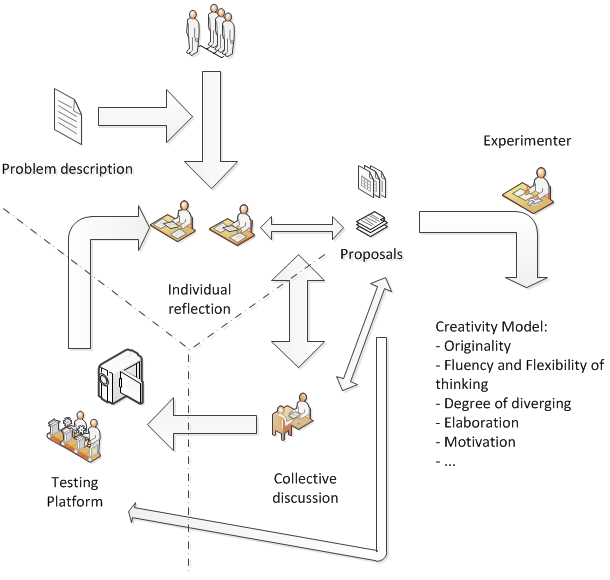Experiments on Creativity
AGORAS defines a set of basic game concepts and models to specify and create 2D game-based ecosystems on a tabletop interface, which will be automatically enacted so that the entities will eventually support user interactions during the simulation.
A general tabletop platform like AGORAS, whose primary activity focuses on playing to create game ecosystems, is complex to design and implement. For our objective of exploring creativity, instead of trying to explore it on such a complex whole platform, some simplifications would be desirable in order to perform a more meaningful and interesting evaluation. The material related to this issue describes a prototype for experimental evaluation purposes intended as a tool for creating physically-based structures (using a digitally-augmented tabletop). It basically includes the core collaborative processes and interactions to be found in the eventual implementation of an AGORAS editor supporting the creation of physically-based entities for a given ecosystem. This prototype has successfully been used in several experiments on creativity with teenagers confronting a physical-only platform without computer mediation. This is an important step forward because it can provide empirical evidence on how this kind of technology and interaction techniques can foster creativity over traditional physical-only settings, and establishes the foundation of the AGORAS creation support.


Two different creative collaborative tasks have been involved in the experiments on both platforms. The first task consisted of the creation of entity structures freely, which involved more artistic facets and simple use of physical building blocks. The second task was inspired by the idea of solving problems by means of Rube Goldberg Machines (RGMs), which are mechanical systems mainly composed of building blocks connected to actionable devices, normally providing a complex solution to a simple problem.

An experimental loop with individual reflection, collective discussion, testing places was considered in the expeirments. From these experiments, we have observed that in terms of creativity traits, interactive surfaces seem promising as groups working in the digital platform showed significantly more performance in fluency of thinking, were more motivated, and novelty was found near to significance. Also some issues related to collaboration and interaction were analyzed. In particular, the co-operation, the retrial fine adjustment, and the dominance showed that the properties of an interactive surface tabletop suits better for facilitating the sharing of objects and participation in conditions of co-operation by co-located participants. The results also showed that the loop with the reflection and discussion places (activities performed there) is working properly, and that the activies performed there are relevant and effective for the improvement of the participation in the task at hand and the exchange of ideas.
[VIDEOS]
You can find more information and details in Chapter 3. Some of this work and its related issues have been published in the following articles:
• Alejandro Catala, Javier Jaen, Betsy van Dijk, and Sergi Jordà. 2012. Exploring tabletops as an effective tool to foster creativity traits. In Proceedings of the Sixth International Conference on Tangible, Embedded and Embodied Interaction (TEI '12), Stephen N. Spencer (Ed.). ACM, New York, NY, USA, 143-150. [Download]• Alejandro Catalá, Fernando García, Jose Azorín, Javier Jaén, Jose A. Mocholí. Exploring Direct Communication and Manipulation on Interactive Surfaces to Foster Novelty in a Creative Learning Environment. International Journal of Computer Science Research and Application 2012, Vol. 02, Issue. 01 (Special Issue. Extended Selected Papers ICVL2011), pp. 15-24. ISSN 2012-9572. [Download]
• Alejandro Catalá, Javier Jaén, Adrià A. Martínez, Jose A. Mocholí. AGORAS: Exploring Creative Learning on Tangible User Interfaces. In Proc. Compsac, IEEE 35th Annual Computer Software and Applications Conference, pp.326-335, 2011. (ISBN 978-0-7695-4439-7) [Download]
• Adrià Agustí Martínez, Alejandro Catalá, Javier Jaén, Jose A. Mocholí. CRETASICO: Un entorno de simulación de física para superficies interactivas. Actas de las Jornadas de Ingeniería del Software y Bases de Datos,“JISBD 2011”, pp. 975-988, 2011 (ISBN: 978-84-9749-486-1). [Download]
• Alejandro Catalá, Fernando García, Jose Azorín, Javier Jaén, Jose A. Mocholí. Exploring. Direct Communication and Manipulation on Interactive Surfaces to Foster Novelty in a Creative Learning Environment. Proceedings of the International Conference on Virtual Learning (ICVL’11), pp. 373-379, - Distinguished with the *Excellence Award* 2011. [Download]
© Alejandro Catalá and the respective copyright holders for specific materials
